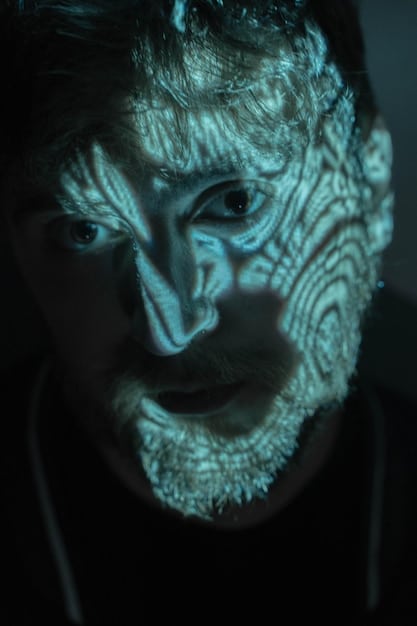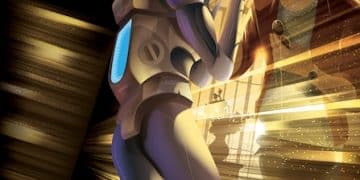The Villain’s Journey: Unpacking Motivations of Complex Movie Antagonists

The Villain’s Journey delves into the complex motivations that drive seemingly evil characters in film, exploring the events and choices that shape their descent into villainy, and often revealing a more nuanced, human side.
The allure of a compelling villain is undeniable. But what makes some movie villains truly captivating? It’s often the depth and complexity of their motivations. Join us as we embark on the villain’s journey, exploring the driving forces behind some of cinema’s most memorable antagonists.
Understanding The Villain’s Journey
Every hero needs an antagonist, but what elevates a simple bad guy to a truly memorable villain? The answer often lies in their motivations, their backstories, and the events that led them down a path of darkness. Exploring the villain’s journey helps us understand not just *what* they do, but *why* they do it.
Often, exploring these characters humanizes them in unexpected and interesting ways creating a connection with audiences even as they root against them on screen. The depth of these characters help to fuel the narrative with complex motivations.
The Key Elements of a Believable Villain
A well-crafted villain isn’t simply evil for the sake of evil. They have reasons, justifications, and perhaps even a twisted sense of righteousness that drives their actions. What are the defining ingredients?
- A Compelling Backstory: Often, a villain’s past experiences shape their present actions.
- A Clear Motivation: Understanding *why* they’re doing what they’re doing is crucial.
- Internal Conflict: The best villains often struggle with their own choices and actions.
- Relatability (to a degree): Even in their villainy, there’s something human that audiences can connect with.
In conclusion, understanding the villain’s journey demands considering the origin stories and personal motivations beyond the villain’s actions. This insight is crucial for appreciating how villainous characters are developed in storytelling.
Darth Vader: From Hero to Dark Lord
Anakin Skywalker’s transformation into Darth Vader is a prime example of the villain’s journey. He starts as a promising young Jedi, full of potential, but ultimately succumbs to fear, anger, and the allure of power.
The tragedy of Darth Vader lies in his good intentions gone awry. His desire to protect those he loves, coupled with the manipulative influence of Emperor Palpatine, leads him down a dark and destructive path.

The Role of Fear and Loss
Anakin’s fear of losing Padmé, his secret wife, is a major turning point. Palpatine exploits this fear, promising him the power to prevent death, ultimately leading him to embrace the Dark Side.
The loss of his mother, the perceived betrayal by the Jedi Order, and his own failures all contribute to his growing disillusionment and anger. These factors serve as the basis for the ultimate tragedy.
- The Death of His Mother: Anakin’s rage and grief after her death sets him on a path of revenge.
- The Jedi Order’s Mistrust: Anakin feels constrained and misunderstood by the Jedi Council.
- Palpatine’s Manipulation: The Emperor skillfully preys on Anakin’s fears and insecurities.
Ultimately, Darth Vader serves as a critical example in the villain’s journey because of his well-developed backstory which shapes his decisions. The ability to identify with his past makes the character all the more compelling.
Erik Killmonger: A Product of Systemic Injustice
Erik Killmonger, from *Black Panther*, presents a different kind of villain’s journey. He’s not motivated by personal gain or a lust for power, but by a desire to liberate oppressed people and avenge historical injustices.
Killmonger’s motivations are rooted in the pain and suffering he experienced as a child, abandoned by Wakanda and forced to grow up in a world shaped by racism and inequality. His anger is understandable, even if his methods are extreme.
The Impact of Abandonment and Racism
Growing up without a connection to his Wakandan heritage, Killmonger feels betrayed and resentful. He sees Wakanda’s isolationism as a form of complicity in the oppression of Black people around the world.
His experiences with racism and discrimination fuel his desire to fight for liberation, but also harden him and make him willing to use violence to achieve his goals. A goal that could be considered noble but the path he takes is questionable and causes him to become a villain.
- Wakanda’s Isolationism: Killmonger views Wakanda’s refusal to intervene in global affairs as a moral failure.
- The Legacy of Colonialism: He sees the oppression of Black people as a direct result of historical injustices.
- A Desire for Revenge: Killmonger wants to use Wakanda’s technology to empower oppressed communities and exact revenge on their oppressors.
In summary, Erik Killmonger provides a stark illustration of * the villain’s journey*, showing how a life filled with pain and injustice can motivate extreme actions. His character highlights the importance of historical context in understanding a villain’s choices.
Amy Dunne: The Sociopathic Mastermind
Amy Dunne, the protagonist (or rather, antagonist) of *Gone Girl*, offers a chilling example of the villain’s journey. She’s intelligent, beautiful, and seemingly perfect, but beneath the surface lies a manipulative and sociopathic mastermind.
Amy’s motivations are complex and unsettling. She’s driven by a desire for control, a need to be admired, and a deep-seated sense of entitlement. When she feels wronged or bored, she’s willing to go to extreme lengths to get what she wants.

The Perils of Perfectionism and Entitlement
Amy’s “Amazing Amy” persona, cultivated since childhood, creates immense pressure for her to maintain a perfect image. When her marriage falters, she feels betrayed and decides to punish her husband in a spectacular and ruthless way.
Her sense of entitlement leads her to believe that she deserves to be happy, regardless of the cost to others. She sees herself as a victim, even as she’s orchestrating elaborate schemes to manipulate and control those around her.
- The “Amazing Amy” Persona: The pressure to live up to an idealized image fuels her insecurities.
- A Need for Control: Amy thrives on manipulating situations and people to her advantage.
- A Lack of Empathy: She’s unable to truly understand or care about the feelings of others.
In conclusion, Amy Dunne’s story is a dark exploration of the villain’s journey, highlighting how perfectionism and entitlement can lead to sociopathic behavior. It serves as a stark contrast, with a lack of empathy as a central component of this villain’s motivations.
Common Threads in The Villain’s Journey
While Darth Vader, Erik Killmonger, and Amy Dunne come from vastly different backgrounds and are driven by different motivations, their stories share some common themes that are found throughout the villain’s journey.
Understanding these shared characteristics allows to better understand their character development, and the impact those characters can have on the story. Also recognizing that there are various ways someone can become a villain.
The Importance of Empathy (or Lack Thereof)
One key element is the presence or absence of empathy. While some villains, like Killmonger, are driven by a deep sense of empathy for a particular group of people, others, like Amy Dunne, lack empathy altogether.
Even villains who start with good intentions, like Darth Vader, can lose their empathy as they descend into darkness, becoming consumed by their own pain and anger. It’s that slow change that truly defines them and sets the stage for the rest of their actions.
- Empathy as a Motivator: Some villains are driven by a desire to help others, even if their methods are misguided.
- The Loss of Empathy: Villains can become so consumed by their own goals that they lose sight of the impact of their actions on others.
- The Absence of Empathy: Some villains are simply incapable of understanding or caring about the feelings of others.
In summary, the villain’s journey often highlights whether a villain is motivated by empathy or a lack thereof, which dramatically shapes their actions. This element is key to understanding and assessing villainous behavior.
Why We’re Drawn to Complex Villains
Despite their reprehensible actions, complex villains like Darth Vader, Erik Killmonger, and Amy Dunne often capture our attention and spark our imaginations. But why are we so drawn to these characters and their twisted ideals?
One reason is that they challenge our understanding of good and evil. They show us that even the most seemingly evil people have motivations and backstories that can help us understand their choices, even if we don’t condone them.
Exploring the Dark Side of Human Nature
By exploring the motivations of complex villains, we can gain a deeper understanding of the dark side of human nature. We can see how fear, anger, loss, and injustice can lead people down a path of darkness.
It allows us to confront uncomfortable truths about ourselves and the world around us. It is that raw honesty that compels an audience to care about such characters, even as they commit heinous acts.
- Challenging Moral Absolutes: Complex villains blur the lines between good and evil.
- Exploring Societal Issues: Villains can reflect and comment on real-world problems like racism, inequality, and injustice.
- Understanding Human Psychology: Villains provide insights into the motivations and behaviors of individuals and groups.
In conclusion, the villain’s journey attracts audiences because it challenges the boundaries of morality and grants insight into the more shadowed aspects of human behaviour, offering a unique viewpoint on human nature.
| Key Point | Brief Description |
|---|---|
| 🎭 Compelling Backstory | Villains gain depth from well-developed origin stories and formative events. |
| 🎯 Clear Motivation | Understanding why villains act enhances audience engagement. |
| ⚖️ Internal Conflict | Villains with inner struggles resonate deeply with viewers. |
| 💔 Empathy (or Lack Of) | A villain’s capacity for empathy greatly determines their actions and appeal. |
Is ▼
The Villain’s Journey explores the motivations behind antagonists, revealing complex reasons for their actions beyond simple evil, adding depth to their character.
His motivations stem from the systemic injustices and the oppression he witnesses, making his actions understandable even when his methods are extreme.
He was manipulated by fear, loss, and the allure of power, particularly by Emperor Palpatine, ultimately leading him to embrace the Dark Side.
Amy is driven by a need for control, a desire for admiration, and a deep-seated sense of entitlement, leading to manipulative and ruthless actions.
Complex villains challenge our understanding of good and evil, reflecting societal issues and offering insights into human psychology, making them fascinating.
Conclusion
Exploring the villain’s journey provides key insights into the motivations and backstories of evil characters, blurring the boundary between good and evil, and providing viewers with greater insights into human identity. Recognizing common themes such as empathy, societal issues, and morality, we gain insight into human psychology through these complex characters.





